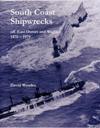For full information on wrecks, detailing the circumstances of loss, photographs of the ships, positions where known and much more, the books for all wreck divers and which is a must for your bookshelf is South Coast Shipwrecks off East Dorset & Wight 1870-1979, and the later work, Supplement to South Coast Shipwrecks off East Dorset & Wight 1870-1979, both available through www.wightspirit.co.uk More than 200 wrecks are covered in detail together with circumstances of loss, historic images, photos of artefacts, accurate position where known, etc.
By arrangement I can also put you on any number of wrecks on the east side of the Isle of Wight where depths are shallower. Usually it’s unlikely I’d do any of these wrecks on a single day from Lymington due to the distances involved but I can do 2 consecutive days or more by running out of Gosport or Southsea. Take your pick: First World War: SS KURLAND, SS ELFORD, HMS BOXER, SS CAMSWAN, SS POLO, SS LEON, SS HIGHLAND BRIGADE, sailing ship CISSIE, SS CAMBERWELL, HMS P12 (stern section), SS FRANCE AIMEE. World War Two: SS CUBA, SS PRINCE LEOPOLD, German U-boat U-1195. And finally, a wreck from the 1880’s, SS GERARDA.
Wrecks in less than 10 metres of water, shallowest to deepest:
British steamer TEESDALE, wrecked on the north-east Shingles in 1872. Single boiler and single cylinder engine. Depth 5 metres. Subject to archaeological survey during 2010. Depth of shingle can vary from tide to tide, and diving on slack neaps is preferred. On LW slack there is only .75 metre of water clear over the top of the wreck. Very rarely dived.
British steamer WHEATFIELD, 1963 tons, ran aground in dense fog at Rocken End near St Catherine’s Point in December 1882. Quite flat though a boiler still stands. Much wreckage has been pressed into the seabed through stress of ground swells and weather. A rummage second dive in 6 metres.
British steamer CORMORANT, 2255 tons, ran aground in dense fog near Whale Chine in December 1886. Heavily salvaged at the time, the remains are quite flattened in about 6 metres on a seabed of sand and shingle.
Steam barge CERES, 38 tons, wreck at Hurst Castle in 1898, close inshore. Depth about 15 metres. Much iron plates and other wreckage buried in the shingle and chalk seabed.
British steamer CLAREMONT, 1129 tons, ran aground in dense fog in January 1881. Wreck is flattened and lies on a sand and shingle seabed in about 6 metres.
British steamer NEWBIGGIN, 1366 tons, ran aground in dense fog on Typit Ledge near Atherfield Point in April 1880. Wreck lies in 6 metres of water, very flattened and scattered, though the propeller and shaft stand clear. Wreck lies among clean, hard rock seabed, carved into strange features by the action of the sea. An interesting second dive with the chance of stumbling across artifacts from the many vessels wrecked here.
German steamer ESSEN, 1248 tons, ran aground in dense fog close to St Catherine’s Point in March 1881. Wreckage is very flattened and lies among a seabed of sand, shingle and rock in about 6 metres.
British wooden warship HMS POMONE, stranded on the Needles in 1811 but broke up and a substantial part drifted into Alum Bay. Timbers, iron knees and keel pins show above the sandy/rocky seabed in 6-7 metres. If you don’t know what an old wooden wreck looks like, you’ll know after you’ve been on this one.
British steamer CASTLE CRAG, 2428 tons, this nearly new steamer ran aground in fog half a mile offshore in December 1883. Wreck is quite flat but extensive, lying among rough ground comprising gullies and rock ledges. Two boilers and the windlass are still there with areas of plate. Wreck seems to have broken its back on a large, humped rock. A good second dive in 6-9 metres.
Greek steamer JOANNIS MILLAS, 2,071 tons, ran aground in fog half a mile offshore in January 1896, not far from the Caslte Crag (see above). Wreckage lies among gullies and ledges. Boilers can be seen beneath debris, triple expansion engine exposed, lying hard to starboard, propeller shaft stands clear. Largely broken up in 6-8 metres but a good second dive with lots of small fry living around the rocks.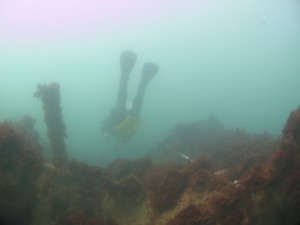
All these wrecks except the Teesdale can be dived at pretty much all states of the tide.
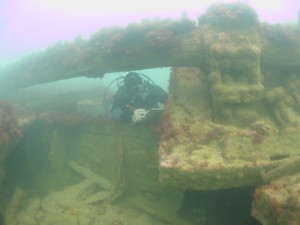
Beneath the propeller shaft and supporting bearing on the SS Joannis Millas, and swimming over upstanding frames and girders
Photos courtesy of Hampshire & Wight Trust for Maritime Archaeology
British steamer SERRANA. Bow section of this 3677 ton steamer lies on the Bridge Reef, Needles, an exposed site, where it came to rest after being torpedoed by UB-35 in January 1918. Well broken up but some cargo still evident in 7-9 metres.
Debris field from HMS GLADIATOR. This British cruiser sank in shallow water following collision in April 1908. The vessel was eventually raised, but much debris remains on the seabed as some of the vessel’s top hamper was cut away to facilitate salvage. Depth 7-9 metres on shingle seabed.
British steamer MECHANICIAN, 9044 tons, armed ocean escort ship, torpedoed by UB-35 in January 1918. Sank in the Needles Channel on the edge of the Shingle Bank and broke in two. Wreck covers and uncovers with shingle – usually buried, sometimes partly exposed. Depth varies considerably due to movement of shingle, but about 9 metres when exposed.
Wrecks in 10 to 20 metres of water, shallowest to deepest:
British steamer WAR KNIGHT, 7951 tons, set on fire and badly damaged in collision, taken in tow but struck a mine laid by UC-17 , and then shelled by our own forces in March 1918. Large upright wreck with 3 boilers and a turbine engine – the earliest merchant ship wreck with this type of engine. Chain locker and windlass stand high at the bows. Heavily salvaged in the 1960’s but still an extensive wreck in 13 me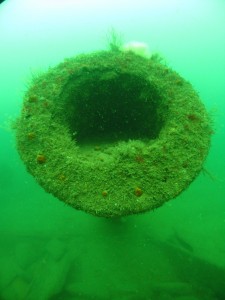 tres, and a good second dive.
tres, and a good second dive.
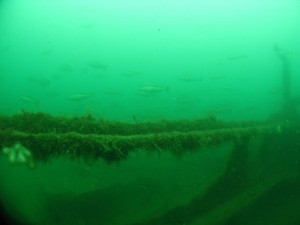
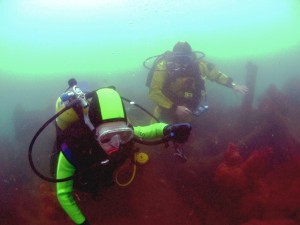
Diving the wreck of the War Knight. Ideal second dive in 13 metres
Photos courtesy of Maritime Archaeology Trust
British motor vessel MARGARET SMITH, 309 tons, capsized off Yarmouth in the western Solent in June 1978. An intact wreck lying on its side in 15 metres and one best done on neap tides when the visibility is better.
British steamer FERNCLIFFE, 547 tons, sank following collision in September 1883. Single boiler, propeller shaft and hull plating evident. Much wreckage buried in mud and slipper limpets. Depth 16 metres.
British steamer CLAN MACVEY, 5818 tons, torpedoed by UB-57 in August 1918. A large wreck, heavily dispersed but lots of wreckage poking up from the sandy seabed. Gun still there. Large steering quadrant at the stern. A haven for flatfish and shellfish though the wreck can be somewhat silty. Depth 18 metres on sand seabed.
British steamer SERRANA, stern section of this 3677 ton ship torpedoed by UB-35 in January 1918. Vessel grounded on the Bridge Reef, broke in two, the stern section floating clear and sinking 1/4 mile away. Two boilers and engine there plus areas of plate. Gun and large propeller at the stern with one of her 7.5″ howitzers standing upright on the port side. Lots of life. Lies in 18 metres though the determined could find 20 metres depth. Still a substantial wreck.
Wrecks in 20 to 30 metres of water:
British steamer ALGERIAN, 3837 tons, sank in the Solent while under tow after being mined by UC-5 in January 1916. Swarming with shellfish, this large wreck was supposedly dispersed in 1922 but she still stands 6 metres. Seldom dived, she is best visited on a good neap in spring or summer. Depth 22-25 metres. The wreck acts as a collection point for rubbish thrown in the Solent. Don’t be surprised to find traffic cones, patio chairs, drinks cans etc.
Landing Craft (Tank) 809, sunk under tow on 26 September 1945 after being brought back from the D Day landings in a damaged condition. Lies in 21 metres of water on hard ground. Hardly dived, but plenty of wreckage, with the bow door standing up 3 or 4 metres. Wreck is upright. There is doubt as to the true identity of this wreck as LCT-809 was reported destroyed on the D Day beaches. An American LCT of the same number returned from D Day but was later scrapped. It’s probable the British wreck was recovered from the D-Day beaches, returned to the UK and repaired.
Dutch wooden schooner FENNA, sank in heavy weather in 1881. Pile of cargo comprising bar iron which has the appearance of railway lines, blocks of sheet glass and barrels containing iron goods. This wreck is like an oasis in the desert – full of life. Depth 22-24 metres. A popular dive.
British Admiralty steam trawler ALBION II, 240 tons, mined by UC-5 in January 1916. Single boiler and small triple expansion engine stand up, leaning to port. Some wreckage at the bow and stern stands up, but otherwise the wreck is much buried. Depth 24 metres.
Dutch steamer BETSY ANNA, 880 tons, sank under tow in October 1926. Wreck has one main and one donkey boiler. Engine has fallen over. A largely upright wreck. Stern now skeletal. Bow points to the surface. Depth 26 metres.
French steamer VENEZUELA, 730 tons, torpedoed by UB-59 in March 1918. An upright wreck but broken. Twin triple expansion engines and two boilers stand up. Wreck is smothered in fish, and always a popular dive site in 28 metres.
Unidentified wooden schooner, about 36 metres long, with beams, frames and planks showing, as well as a 4.3 metre long bow windlass, anchors and a brass rudder pintle. A lot is still buried …all lying in about 20 metres of water, and we don’t yet know her name or what happened to her. This wreck has a protection order on it and can only be dived under licence.
British TANK LANDING CRAFT, unidentified, almost made it back from D-Day in 1944, upright in 28-30 metres. Wreck has exposed twin diesel engines, generators, huge stern capstan and ladders disappearing into the sand. Bow ramp still there in the closed position.
British steamer KYARRA, 6953 tons, torpedoed by UB-57 in May 1918. Probably the most dived wreck in the UK. Four boilers and twin triple expansion engines. Lots of cargo still in the wreck. Depth 28-30 metres.
Wrecks in 30 to 40 metres of water, shallowest to deepest:
Greek steamer SPYROS, 387 tons, foundered after springing a leak in December 1920. Wreck is upright and largely intact with a single boiler and compound engine. Swarming with fish, she is a popular dive in 30 metres though a metre or two more can be found on the seabed.
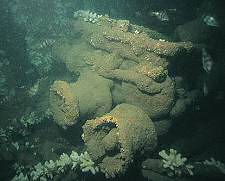
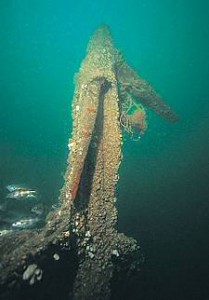
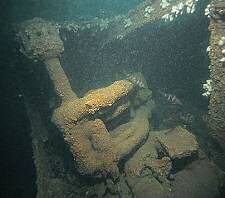
From left, cargo winch, stern tiller arm and steering engine on the wreck of the Spyros
Photos courtesy of John Liddiard www.jlunderwater.co.uk
Norwegian steamer ASBORG, 2751 tons, torpedoed by UC-75 in January 1918. Large single boiler and triple expansion engine stand up well. Evidence of steel cargo forward of the boiler. An upright wreck and a good dive in 30 metres. Tide on HW can turn quickly, so make sure you’re in the water at the start of slack.
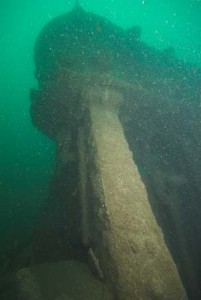
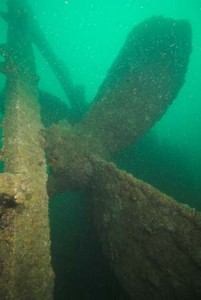
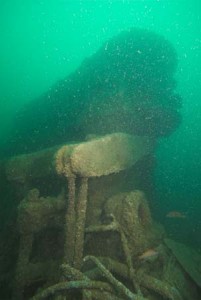
From left, Asborg’s triple expansion engine, propeller, and operating levers on the engine
Photos courtesy of John Liddiard www.jlunderwater.co.uk
French warship/motor vessel CARENTAN, 107 tons, capsized in heavy weather and sank December 1943. Twin diesel engines. Breaking up in 30 metres of water.
Norwegian Steamer BORGNY, 1149 tons, sunk in February 1918, presumed after striking a stray mine. Wreck lies mostly on its starboard side though the stern is almost upside down. Swarming with fish and a popular dive in 31 metres.
Irish steamer CASTLE REAGH, 443 tons, foundered in a storm February 1925. Single boiler and compound engine are the highest parts of this upright wreck. Depth 33 metres.
Dutch motor tug WITTE ZEE, 328 tons, sprang a leak and sank in February 1964 while undertaking a salvage operation. Upright, largely intact wreck, smothered in fish, in 33 metres. A good dive.
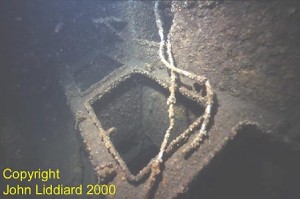
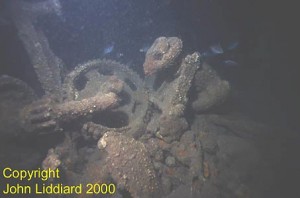
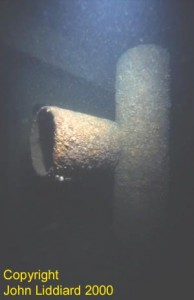
Skylights or lockers, broken anchor windlass and samson post on the wreck of the tug Witte Zee
Photos courtesy of John Liddiard www.jlunderwater.co.uk
British steamer WAPELLO, 5576 tons, torpedoed by UC-71 in June 1917. A large wreck which lies on its side in 33 metres.
British Admiralty steam trawler NEW DAWN, 93 tons, mined by UC-17 in March 1918. A small but interesting wreck, fairly broken. Single boiler and compound engine. Lots of life. Lies in 33 metres.
Belgian steamer INDUTIOMARE, 1577 tons, torpedoed by UC-61 in July 1917. Lying half over on her port side, one boiler is almost buried while the other stands up. Triple expansion engine stands clear, leaning to port. Lies in an area of sand which covers and uncovers. Gun on the stern. Depth 34 metres.
British steamer BRAEDALE, 406 tons, alleged to have sunk through stress of weather in October 1932, but in fact deliberately scuttled to claim insurance. Wreck lies on its starboard side with a single boiler and triple expansion engine. Swarming with fish, and a popular dive in 35 metres.
Norwegian steamer MOLINA, 1122 tons, torpedoed by UB-35 in January 1918. Upright from midships forward. Two boilers and triple expansion engine stand up. Stern area flattened. Lots of life, and a popular dive in 35-40 metres, though the determined may find a few metres deeper.
British Admiralty steam trawler WARWICK DEEPING, 445 tons, shelled in October 1940. Armed anti-submarine vessel completely upright and largely intact still looking like a ship, with the wheelhouse still standing and gun on the bows. A popular dive in 36 metres.
British schooner FLORENCE LOUISA, scuttled by the Germans in 1917. Lies in about 37 metres on one side. Cargo of scrap steel is most evident standing 4 metres, together with anchors, deadeyes, copper/brass hull rivets, some 2′ long. Site only discovered in 2023 – further investigation to be carried out.
British Admiralty motor vessel HMS BOREALIS, 451 tons, bombed by aircraft in August 1940. Lying half to starboard, this barrage balloon vessel is reasonably intact, though the bow section is badly damaged. Lies in 38 metres. A nice dive.
British submarine HMS UPSTART, 648 tons, sunk as a sonar target in July 1957. More or less upright and intact but leaning to starboard. Her bridge, conning tower and propellers have been removed. Depth 38 metres. A good dive.
British steamer, probably the HAZELWOOD, 3120 tons, sunk by U-boat 0n 19 October 1917. Large wreck lying in 36 metres of water. Wreck covers and uncovers with sand – when exposed there’s a lot to see, with 2 large boilers, broken engine, bow heavily on its starboard side and broken iron hull and fittings throughout the site. Lies on clean white sand usually giving good light reflection and good vis. A 4-5 metre high sand bank migrates backwards and forwards across the site.
British barquentine ROSE HILL, 200 tons, lost in collision in September 1900. Well broken and fairly flattened in 38 metres.
British steamer FALLODON, 3,012 tons, torpedoed by UC-71 in December 1917. Wreck lies on its port side across the tide in 38 metres. Two boilers, one still in the wreck, triple expansion engine visible beneath hull plate. Gun at the stern.
British Admiralty steam trawler CRESTFLOWER, 367 tons, bombed by German aircraft and sunk in July 1940. Single boiler and triple expansion engine, bow gun lying on the seabed port side of the bows. Depth 38 metres.
British steamer BARON GARIOCH, 1831 tons, torpedoed by UC-63 in October 1917. Upright wreck with triple expansion engine and two boilers standing up. Gun at the stern. Lies in 38 metres.
British steamer SOUTH WESTERN, 674 tons, torpedoed by UB-59 in March 1918. Wreck is lying on its starboard side with one boiler exposed and the other visible under hull plating. Triple expansion engine on its starboard side. Much of the bow has been destroyed, presumably by the torpedo explosion. Seabed depth about 38 metres.
British steamer NETLEY ABBEY, 1630 tons, sunk in collision with HMS Surprise in 1899. Two large boilers and compound engine, which lies hard over. Wreck lies across the tide. Deadeyes and some coal cargo still evident, in 38 metres.
PENMARCH, 996 tons, sunk in collision in 1929, lies in about 35 metres, and stands about 6 metres. Two boilers are the highest part, with plenty of cargo of glass, tubes and crockery on site.
Wrecks in 40 to 50 metres, shallowest to deepest:
British steamer TWEED, 1025 tons, torpedoed by UB-59 in March 1918. More or less upright in 40 metres with two boilers and a triple expansion engine leaning heavily to starboard. Debris lies off the wreck to starboard. A good dive.
Irish steamer LAPWING, 841 tons, lost in collision in July 1872. Lies across the tide on hard ground, her compound engine lies hard over to starboard and her single boiler and donkey boiler lie close together. Unusual boiler design and unusual cargo winches showing. Fairly flat in 40 metres.
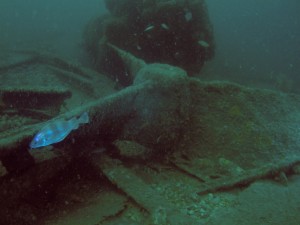
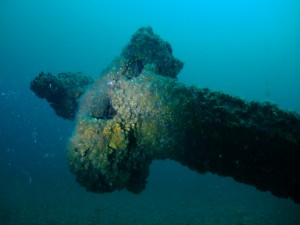
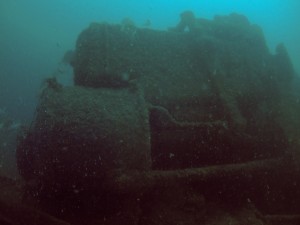
Spare propeller, stern post and main compound engine on the SS Lapwing.
Photos courtesy of Dave Robbins
British steamer REDESMERE, 2123 tons, torpedoed by UB-40 in October 1917. Lying half over on her port side. Two boilers and triple expansion engine amidships. Gun at the stern. Depth 40 metres.
British steamer BRITANNIA,(believed), 765 tons, torpedoed by UC-75 in October 1917. A small wreck with two boilers and a triple expansion engine lying on its starboard side. Depth 40 metres.
Canadian steamer ALBERT C FIELD, 1764 tons, bombed by aircraft in June 1944. Lots of small pieces of exploded ammunition. The triple expansion engine and boilers is right aft and the bridge is right forward. Everything in the middle was cargo space. Depth 40 metres.
British steamer WESTVILLE, 3207 tons, torpedoed by UB-35 in December 1917. Lying half to port, this large wreck lies across the tide and has a stern gun, two boilers which have rolled a short distance from the wreck and a large triple expansion engine which leans to port. The whole bridge has slipped onto the seabed. Depth mainly 40 metres though 2 or 3 metres deeper can be found just off the wreck.
British steamer MENDI, 4230 tons, sank following collision in February 1917. Large wreck with 4 boilers and triple expansion engine. She is armed with a stern gun. Wreck has settled half to starboard. More than 650 men, most of them South African military labourers, lost their lives in the sinking. Depth 40 metres.
French steamer BRESTOIS, 348 tons, sunk in collision in March 1918. Compound engine lies on its port side, single boiler, bow lies on its port side. Broken but parts cover and uncover in 40 metres.
French steamer LISTRAC, 778 tons, shelled in October 1940. Upright wreck with a single boiler and triple expansion engine fitted aft. Depth 40 metres.
British steamer TERLINGS, 2318 tons, bombed by aircraft in July 1940. Deep scour amidships. Two boilers and triple expansion engine stand up. Wreck lies half to starboard in 40 metres, though 45 metres can be found in the scour.
French steamer AZEMMOUR, 897 tons, torpedoed by UB-59 in March 1918. Upright wreck with two boilers and a triple expansion engine standing up. Fairly intact from midships forward. Stern gun. Depth 40 metres. A nice dive.
British steamer IDUNA, 859 tons, sank following collision in May 1883. Upright and remarkably intact aft of the boilers. Two boilers and a compound engine stand up. The bow section lies to starboard and is skeletal. Coal cargo evident aft of the engine. Depth 40 metres. A good dive.
British steamer EMPIRE CRUSADER, 1042 tons, bombed by aircraft in August 1940. Two boilers evident, one standing on end. Engine covered with plating. Gun at the stern. Depth 40 metres.
Dutch steamer AJAX, 942 tons, bombed by aircraft in August 1940. Lying half to port, one of her two boilers is almost buried in sand. Triple expansion engine stands up. Bow section lies on its port side. Depth 40 metres.
British steamer ELEANOR, 1980 tons, torpedoed by UB-57 in February 1918. Upright wreck with two boilers and a triple expansion engine which lies on its starboard side. Cargo of mines and depth charges. Aft of the engines, the wreck tends to flatten out slightly before rising again where there is another large hump of cargo. Gun and large steering quadrant at the stern. Depth 40 metres. Interesting dive sometimes confused as being two wrecks.
British steamer COQUETDALE, 1597 tons, bombed by aircraft in August 1940. Large area of plating amidships blown outwards. Two boilers and triple expansion engine stand up. Depth 40 metres.
British motor vessel POOL FISHER, 1028 tons, sank in heavy weather in November 1979. Lies upside down in 40 metres.
Belgian steamer ESPAGNE, 1463 tons, torpedoed by UC-71 in December 1917. Well broken and fairly flat. Triple expansion engine lies on its side and one of the two boilers stands on one end. Lots of fish. Depth 40 metres.
Norwegian steamer BRAATT II, 1834 tons, torpedoed by UB-30 in March 1918. Lies on her port side. Triple expansion engine lies almost upside down. Two boilers. Bows lie on their port side fairly flattened. Quite a lot of wreckage along the port side of the wreck. Depth 40 metres.
Belgian steamer LONDONIER, 1870 tons, torpedoed by UC-71 in March 1918. Upright wreck with two boilers and triple expansion engine standing up well. Gun lies on its side at the stern. Depth 40 metres. A good dive.
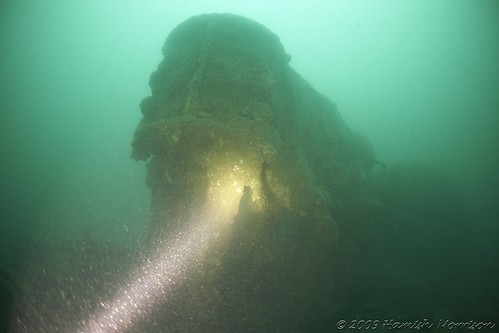

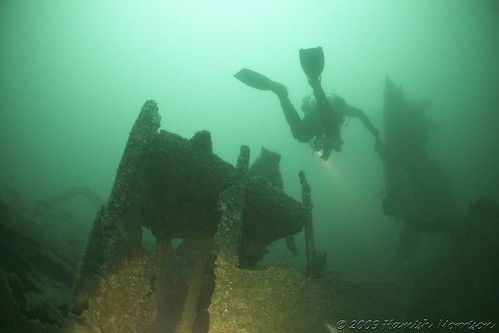
Diver on the wreck of the SS Londonier
Photos courtesy of Hamish Morrison
British steamer HARTLEY, 2147 tons, sank following stress of weather in November 1924. Wreck lies half to starboard. Triple expansion engine lies on its starboard side. Two boilers. Depth 40 metres.
Steam tug SECURITY, 189 tons, sank following stress of weather in December 1946, not helped by the fact she was known to be in poor condition.Wreck lies half over to port. Single boiler and triple expansion engine. Depth 40 metres.
Belgian steam trawler NEREE (believed), 230 tons, sank after springing a leak in February 1926. Wreck lies on its starboard side. Single boiler and triple expansion engine leans hard to starboard. Large winch immediately forward of the boiler. Depth 40 metres.
British steamer CLARINDA, 1075 tons, sunk in collision in October 1885. An upright wreck with two boilers and compound engine, with scattered plating and other wreckage lying to starboard. Depth 40 metres. A good, safe, open dive.
British Admiralty steam drifter WATERLILY, 82 tons, sunk following collision in July 1915. Single boiler and compound engine. A small wreck in 40 metres.
Italian steamer GALLIA, 2744 tons, torpedoed by UB-40 in October 1917. Wreck lies on its port side. One of her two boilers stands on end, with the triple expansion engine lying under hull plating. A large wreck in 40 metres.
Italian steamer DERNA, 2260 tons, sunk in collision in December 1912. Two boilers, triple expansion engine lies almost upside down. A 40 metre dive.
British motor vessel ASHANTI, 534 tons, torpedoed and blown up by E-boat in June 1944. Broken and flattened in 40 metres.
British sailing barque SIMLA, 2288 tons, sank in January 1884 following collision. Full of cargo such as bottles, plates, cement, glass, traction engines. Upright wreck where the sides have collapsed outwards, leaving a hump of cargo. Several large anchors at the bows. Extensive wreck in 40 metres. An interesting dive – she was the ship which took the Light Brigade to the Crimea War in 1854 which led to ‘The charge of the Light Brigade.’
Danish steamer AVANTI, 2128 tons, torpedoed by UB-59 in February 1918. Two boilers and triple expansion engine. Depth 40 metres.
British steamer ORIFLAMME, 3764 ton tanker, mined by UC-63 in November 1917. Two boilers and triple expansion engine evident at the stern in 40 metres, donkey boiler has rolled down the slope in 46 metres. Not a dive for the faint hearted. Vessel lies in an area affected by strong tides producing eddies and overfalls which has scoured the rock seabed clean. Lying on her starboard side, the stern is the highest part. Spare propeller amidships.
Norwegian steamer CUBA, 731 tons, sunk in collision in February 1917. Upright in 42 metres, single boiler and compound engine being the highest parts.
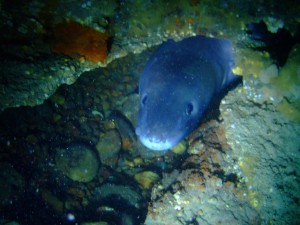
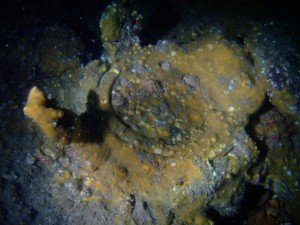
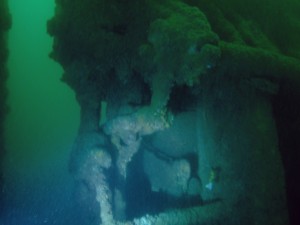
Images from the SS Cuba – conger, porthole and main compound engine
Photos courtesy of Dave Robbins
French sailing ship ERNEST LEGOUVE, 2246 tons, torpedoed by UB-30 in April 1917. Leaning over towards her starboard side, the stump of the mainmast rises above the wreck. Many large, barrel shaped objects in the wreck, some of which have spilled to the seabed. Deep scour amidships of 45 metres, though this is generally a 40 metre dive.
British steamer EVERLEIGH, 5222 tons, torpedoed by U-1017 in February 1945. A large wreck with three boilers and a triple expansion engine. Depth 40-42 metres.
British steamer APARIMA, 5704 tons, torpedoed by UB-40 in November 1917. Three boilers and twin triple expansion engines. Bows broken and falling back. Gun on the seabed starboard side of the stern. 40 metres depth but 42 metres in the scour at the stern. A good dive.
British Admiralty motor yacht HMS SARGASSO, 216 tons, struck a mine and sank in June 1943. Twin oil engines and twin propellers. Broken in the centre, the stern section is upright, the bow section leans to port. Depth 43 metres.
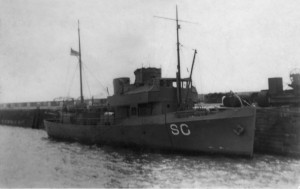
HMS Sargasso
Photo from the Donald Thomas collection, courtesy of Ian Thomas
British steamer CLEDDY, 2173 tons, sank following collision in December 1889. Upright with two boilers and a compound engine which has fallen to starboard. The bow is now skeletal and almost disintegrated. Depth 42 metres. Hardly dived but a good, safe, open dive.
British steamer FLUENT, 3660 tons, mined by UC-65 in July 1917. Large wreck, more or less upright. Three boilers and triple expansion engine, which lies on its starboard side. Cargo forward of the boilers look like shells – they are in fact steel billets. Gun at the stern. Depth 40 metres but 43 metres can be found just off the wreck.
British steamer MYRTLEGROVE, 2642 tons, sank following collision in November 1917. Two boilers amidships one of which has rolled to the seabed. The triple expansion engine is accessible beneath hull plating. Gun at the stern. Wreck lies on its port side and stands quite high. Depth 40 metres though 44 metres can be found in the scour at the stern. An excellent dive.
Norwegian steamer START, 728 tons, torpedoed by UB-58 in December 1917. Small upright wreck with a single boiler and donkey boiler. Triple expansion engine lies on its port side. Foremast still standing. Depth 43 metres.
British Admiralty steam drifter JOHN MITCHELL, 89 tons, sunk in collision in November 1917. A small wreck with a single boiler and triple expansion engine leaning to port. Small gun at the bows. Depth 43 metres.
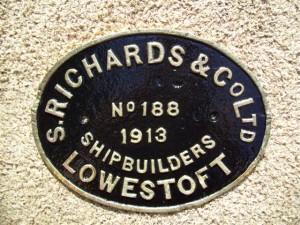
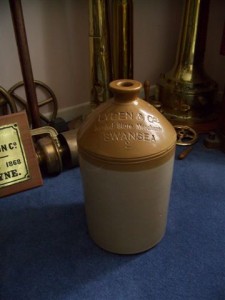
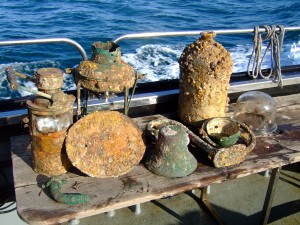
From left – builder’s nameplate after restoration, signalling lamp, builder’s nameplate, anchor lamp, bell and bracket, compass and 2 gallon rum flagon, and rum flagon after cleaning, recovered from the wreck of the John Mitchell
Centre photo courtesy of Dave Robbins
Norwegian steamer AALESUND, 414 tons, torpedoed by UC-71 in January 1918. Single boiler and triple expansion engine. Wreck is twisted – bows upright, stern section upside down with the propeller the highest part of the wreck. Depth 43 metres. Hardly dived.
Danish steamer VERA, 662 tons, sank following collision in January 1874. Upright with a single boiler and two donkey boilers. Compound engine leans over. Broken in 46 metres.
British steamer DAYLESFORD, 1406 tons, sunk in collision in April 1911. Two boilers and a compound engine stand up. Coal cargo remains in the wreck. Largely upright but broken in 46 metres. A very good dive.
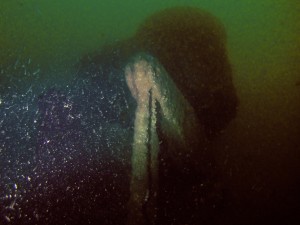
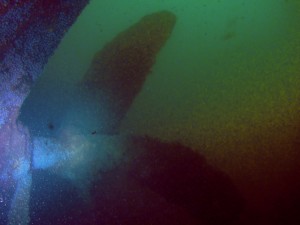
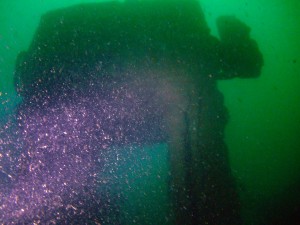
Main compound engine side lever, main propeller and main compound engine, SS Daylesford.
Photos courtesy of Dave Robbins
British paddle steamer NORMANDY, 550 tons, sunk in collision in March 1870. Two boilers and a compound engine. Upright in 48 metres. Amidships machinery section comprising boilers and engines very intact. Only the outline of the bow section visible above the seabed.
British Admiralty steam trawler MICHAEL CLEMENTS, 324 tons, sank after collision in August 1918. Upright in 48 metres and armed with a bow gun. Single boiler and triple expansion engine.
British steamer FORT YALE, 7134 tons, torpedoed in 1944, lying in about 46 metres on its starboard side. A huge wreck with lots to see.
British steamer FLAXMOSS (believed), 286 tons, so she’s a small wreck. Sank in 1887. Lies in about 45 metres, upright but broken. A bell was recovered but it was unmarked. Single boiler and small compound engine fitted aft.
Wrecks in 50 metres to 60 metres of water, shallowest to deepest:
German steamer MESSINA, 1,063 tons, sunk in collision May 1885. One boiler and compound engine. Upright, hull broken, with cargo of iron ore forming a large hump in the wreck. Depth 50 metres.
British LANDING CRAFT. D-Day tank landing craft, identity unknown. Lies in 51 metres. Upright and intact with wheelhouse still standing.
Greek steamer MEANDROS (believed), 4309 tons sunk in collision February 1934. A large wreck, lying on its port side in 55 metres.
Norwegian steamer KONG GUTTORM, 731 tons, torpedoed by UB-103 in July 1918. Wreck is in two upright pieces, the bow section at right angles to the stern section, joined by a debris field. Single boiler plus donkey and triple expansion engine standing up. Depth 55 metres. A good dive.
Steamer OHIO (believed), lying in about 58 metres, two boilers and engine lying hard over to starboard. A good dive.
Danish steamer NORMA (believed), 1997 tons, captured and scuttled by UB-37 in January 1917. Large wreck, collapsed to port. Two boilers and engine leaning hard to port. Bow section broken and pointing vertically, standing 6 metres. Depth 55 metres. A good dive.
Danish steamer INGER, 786 tons, captured and scuttled by UC-18 in December 1916. Two boilers and triple expansion engine stand up. Upright in 55 metres.
Norwegian steamer VIKHOLMEN, 494 tons, torpedoed by UC-71 in September 1917. Single boiler and triple expansion engine stand up. Lies across the tide, upright in 60 metres.
TWO HALVES WRECK, so called because it’s in two halves! Bow section virtually upside down and lying against a reef, but a good dive in 60 metres. Stern section, a quarter of a mile away, also upside down but standing an impressive 8 metres. Cavernous space inside, where there are 2 boilers and a donkey boiler, but strangely, no sign of the engine. Big gaps to swim through and to enter/exit the wreck. Watch out for the family of big congers overhead, staring down at you from the ceiling! No clues so far as to the identity of this ship.
British steamer DUMFRIES, 5149 tons, torpedoed byU-772 in December 1944. Large wreck in 57 metres but 43 metres to the top. Lies partly over to starboard. Three boilers and quadruple expansion engine. Gun at the stern.
British clipper ship SMYRNA, 1372 tons, sank in collision in April 1888. Upright wreck in 54 metres but 57 metres can be found in the scour at the stern. Masts and spars lie on the seabed. Some rigging still stands on the port side. Lots of cargo. Classic clipper bow. A superb dive and definitely one to remember. The most popular tekkie dive in the area and located in The Rips, where visibility is usually very good.
GERMAN U-BOATS. WW1 vintage, surrendered on the Armistice and scuttled in 1921. A number of boats lying in 58 metres.
American motor tanker Y48, 633 tons, sunk by our own forces in January 1945 because she was in a sinking condition. Stands 8 metres, upright and quite intact with a slight list to starboard. Small gun on the bows. Twin screw with a motor cycle in the forecastle. Depth 58 metres and a very good dive.
German U boat U-480, 761 tons, presumed mined in February 1945. Type VIIC U-boat, the wreck is largely intact with a covering of Alberich, a rubber coating designed to neutralise the effects of Asdic. Deck guns in place. Wreck lies in in 58-60 metres. A very good dive.
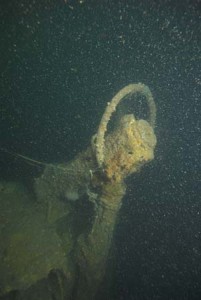
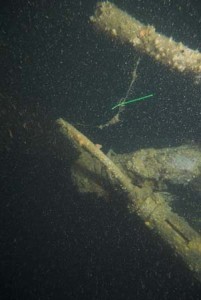
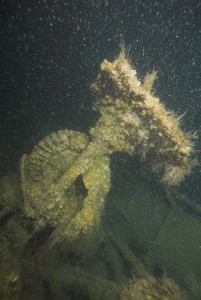
Wreck of the U480, from left, direction finding aerial, periscope parts and anchor winch
Photo courtesy of John Liddiard www.jlunderwater.co.uk
British LANDING CRAFT. D-Day tank landing craft, identity unknown. Lies in 59 metres. Upright and intact with wheelhouse still standing.
Wrecks in 60 to 70 metres of water, shallowest to deepest:
British steamer HOPEDALE, 1746 tons, sunk in collision with the SS Elmsgarth in 1908. Wreck lies diagonally across the tide, half on its starboard side. Interesting mass of machinery at the stern comprising triple expansion engine and boilers. Unusual hull design still visible. Lies on hard ground and shingle in 60 metres.
Norwegian steamer FINN, 3806 tons, torpedoed in 1916, lying hard on one side, with the hull draped down giving the appearance she is upside down – she isn’t. Her hull has opened up giving easy access to the engines and boilers. A good dive.
British steamer EL KAHIRA, 2034 tons, foundered in a storm in July 1922. Large wreck with four boilers and a broken triple expansion engines. More or less upright in 60 metres. A good dive.
Norwegian steamer MONTON, sunk in collision in 1895. Upright but broken in 61 metres.
French liner MEKNES, 6127 tons, torpedoed by E-boat in 1940. More or less upright in 60 metres. 6 boilers, twin triple expansion engines, large wreck with lots to see including many portholes.
British steamer LUXOR, 3571 tons, torpedoed 1918. Lies half over to port in about 58-60 metres. Lots standing up, 2 boilers amidships, engines beneath plating, large gun at the stern
British steamer BISHOPSTON, 2513 tons, torpedoed by UC-16 in September 1917. Two boilers and a triple expansion engine. Lies in 60 metres.
British steamer SNOWDROP, 685 tons, disappeared in a storm in 1886. Single boiler and compound engine, lying bolt upright in 60 metres. A very good dive.
Estonian steamer KOLGA, 3526 tons, bombed by aircraft in July 1940. Large, upright wreck with two boilers and a triple expansion engine. Much lost fishing gear on the wreck, lying in 60 metres.
British sailing barque WAITARA, 883 tons, sank in collision in June 1883. Upright wreck in 60 metres full of export cargo comprising bottles, jars, crockery etc.
American steamer ASHMUN J CLOUGH, 1791 tons, torpedoed by U-989 in August 1944. Upright and largely intact but swathed in lost fishing gear. War cargo of tank tracks, tyres and other military stores. Depth 60-62 metres.
Greek steamer IOANNOS FAFALIOS, 3,122 tons, sank after collision in May 1928. Large upright wreck, with two boilers and a triple expansion engine being the highest parts. Depth 60-62 metres.
British steamer SAXMUNDHAM , 2537 tons, lost in collision in 1888. Two boilers and a huge, very photogenic engine stand up. Bow section has broken off and rests against a cliff face which makes for an interesting dive. Upright in 60 to 62 metres.
German U-boat UB-37 (almost certainly), 263 tons, sunk by gunfire from a Q-ship in January 1917. Wreck lies in 62 metres, bow gun still attached. Ready use ammunition on the seabed. Twin screw, bow torpedo cap open, hatch aft of the engines fallen off.
British motor vessel DALLAS CITY, 4952 tons, sunk by the Luftwaffe in a sustained attack in July 1940. Long thought to lie off Portland, she in fact lies off St Catherine’s Point in 60 metres of water, across the tide. Huge oil engine and single vertical boiler stand up.
British motor vessel GUERNSEY COAST, 650 tons, sunk in collision in August 1964. Wreck is upright and almost intact, standing 13 metres in 62. Large V shaped hole port side aft where collision took place. Very good mid Channel dive.
British steamer BADGER, 89 tons, captured and scuttled by UB-18 in August 1916. Steel steam coaster sunk in 1916. Single boiler and engine are prominent. Tar cargo can be seen in the wreck. Depth about 62 metres.
Norwegian steamer OIEKAST (believed), 600 tons, shelled by U-53 in December 1917. Upright but broken, there is a single boiler and triple expansion engine fitted aft. Depth 62 metres.
Unidentified steel sailing ship, almost certainly the large sailing ship CiITY of CORINTH sunk in 1888. More diving is needed to confirm but she’s in the right area and of the right description. Stern leans to starboard and stands 8 metres, bows lean to starboard and stand 6 metres, in a depth of around 63 metres. Excellent dive.
British steamer SPHENE, 740 tons, captured and scuttled by UB-18 in August 1916. Single boiler and triple expansion engine fitted aft. Bow area broken up, the stern section is more interesting. Depth 65 metres.
French sailing barque EUGENE SCHNEIDER, 2218 tons, sank in collision in December 1926. Packed cargo of railway sleepers remain in the wreck, depth about 67 metres in mid Channel.
British steamer ISLEWORTH, 2871 tons, torpedoed by UC-17 in April 1918. Not for the fainthearted – a challenging dive! Wreck is remarkably intact (wheelhouse floor still above the boilers), but strong tidal streams and the proximity of vertical and transverse reef walls make this a challenging dive. Two boilers and a triple expansion engine. Gun at the stern. Wreck stands 9 metres. Depth 60-70 metres with the seabed sloping away to deeper water.
French steamer ALBERT, sank in circumstances unknown in 1885. Two boilers and compound engine. Lies on a slope in 64-70 metres. A very good dive in mid Channel.
German light cruiser SMS NURNBERG, 4200 tons, sunk by our own forces in July 1922 to test our guns against its armour plating. Lies across the tide. Armoured gun turrets, conning tower, twin bow windlasses, twin propellers are prominent on the wreck, which stands 12 metres in 60-62 metres. A very good dive in mid Channel.
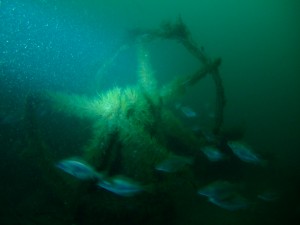
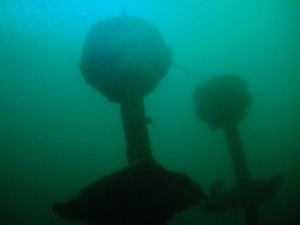
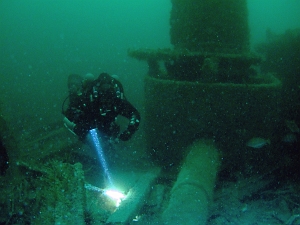
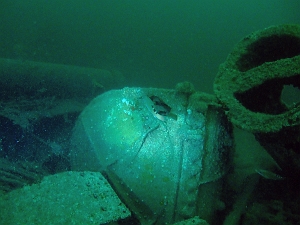
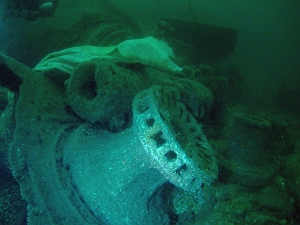
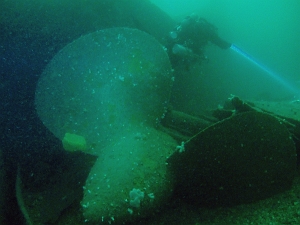
From top left – steering gear on SMS Nurnberg, twin bow windlasses and an unidentified feature. Bottom left – gun and turret, capstan and propeller
Photos courtesy of Dave Robbins.
Danish steamer ASGER RYG, 1134 tons, torpedoed by UB-29 in April 1916. Largely upside down in 70 metres.
British steamer DUNGRANGE, (probably), 621 tons, torpedoed by German S-boat in 1944. Upright in 64 metres. Single boiler and machinery aft. Identity not yet proved but she lies in the right area and the description fits. More diving needed to confirm identity.
A number of German U-boats in depths between 60 and 80 metres, of the type U (ocean going), UB (coastal) and UC (minelaying). All surrendered after the Armistice and scuttled in 1921. Reported to include U-122, U-123, U-152, U-153, UB-122, UC-110.
Wrecks in 70 to 95 metres of water, shallowest to deepest:
Russian motor vessel GORIZONT, Russian factory ship/spy ship of 4404 tons, sunk in collision in December 1975. Stands 20 metres in 72 metres in mid Channel, making this a very substantial wreck.
British steamer OLIVINE, 635 tons, captured and torpedoed by U-33 in April 1915. One boiler and a triple expansion engine are the highest parts of the wreck. Cargo of granite chippings still lie in the wreck, which is upright in 70-72 metres. A good dive in mid Channel.
German motor vessel AUGUSTENBERG, 3639 tons, sunk in collision in April 1962. Large wreck which lies on its side in 74 metres in mid Channel.
British steamer HILDA LEA, (believed), 1328 tons, torpedoed by UB-35 in December 1917. Wreck lies on its starboard side with the bows almost upside down. The two boilers have rolled out. Depth 82 metres. A good dive in mid Channel.
Norwegian steamer BORGSTEN, 1718 tons, torpedoed by UC-64 in December 1917. A wreck thought to be the BORGSTEN lies in 95 metres of water in mid Channel.
Wrecks yet to be located/identified: British steamer OLIVE BRANCH, 1728 tons, lost in collision in 1885. Belgian steam trawler HILDA, 169 tons, lost in collision in 1895. British steamer CLYDE, 307 tons, sank after springing a leak in 1902. British steamer DUNCRAG, 563 tons, foundered in heavy weather in 1904. Spanish steam trawler DOLORES, 67 tons, sprang a leak and sank in 1906. British HMS TIGER, 400 tons, collision in 1908. Norwegian steamer SPIRAL, 1342 tons, captured and scuttled in 1916. British steamer GLYNYMEL, 1394 tons, captured and scuttled in 1917. British destroyer HMS BRUCE, 1530 tons, expended as a target in 1939. Some of these will lie in the thick of the shipping lanes – an area I try to avoid for diving – but it means discoveries are still there to be made.

